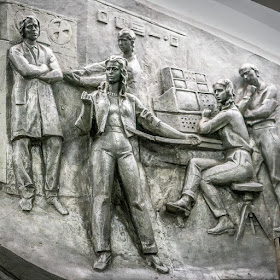 |
| Abdusamat Saparovat at his bee farm |
In July this year, Kyrgyzstan became the first country in the world to end statelessness. The lawyer who spearheaded the work, Azizbek Ashurov, was named the winner of the $150,000 UN Nansen Refugee Award prize.
Ashurov was motivated by his own family's struggle to achieve Kyrgyz citizenship after arriving from Uzbekistan. Working closely with the Kyrgyz government, his organization, Ferghana Valley Lawyers Without Borders (FVLWB) has been offering free
legal assistance to displaced, stateless, and undocumented people.
This inspiring story, written by Kate Bond, was published on the UNHCR website on 30 September 2019 and is posted here with permission.
A breeze brushes through the grass. Donkeys meander along a dirt track. Amid a puff of grey smoke, Abdusamat Saparov opens the first of his 38 beehives.
He smiles, pleased with their progress. Three months ago, when he first bought these colonies, there were 4,000 bees in every box. Now, just like his own dreams, they are thriving, with each holding a whopping 10,000. Their neatly painted, wooden hives dot a patch of land surrounded by yurts and cattle, in the foothills of southern Kyrgyzstan’s mountains.
"It was my dream to be a beekeeper," says Abdusamat. "It’s the process, I like the process of taking care of bees. Of course," he adds, chuckling, "I also love the result, which is honey."
 |
| Abdusamat Saparov beautiful hives |
While his life now has a serene charm, it has been a monumental struggle for 54-year-old Abdusamat to achieve it. Born in Uzbekistan when it was still part of the Soviet Union, he fell in love and married a Kyrgyz woman in 1987, and the pair moved across the border to Kyrgyzstan. The country is "special," he says. "It has an ideal environment – ideal conditions and ideal flowers for the bees."
However, in 1995, his beekeeping hopes were shattered when a new law following the dissolution of the Soviet Union four years earlier left hundreds of thousands of people with invalid passports across Central Asia. Like many, the Saparov family became stateless overnight.
Statelessness blights the lives of millions of people worldwide. Those living without a legal identity document are often denied access to basic rights such as free movement, health care, education and employment.
Without citizenship, Abdusamat was unable to obtain the necessary license for beekeeping and forced to take odd jobs in construction, as he attempted to navigate a bureaucratic nightmare. "It was so difficult," he says, shaking his head. "I didn’t understand the paperwork and my applications for citizenship were refused."
Finally, in 2014, government officials put him in touch with Ferghana Valley Lawyers Without Borders. The organization has spent the last 16 years helping to end statelessness in Kyrgyzstan, in what is being deemed a historic first.
 |
| Azizbek Ashurov, the lawyer who assisted the Saparov family, takes a honey taste test. |
Azizbek Ashurov, 38, was one of the lawyers who helped resolve the family’s case. It took five years.
"I knew it was his life’s dream to open a bee farm," he says. "But it was a very difficult case, because Abdusamat no longer had his old Soviet passport. So, we took it step by step. We started with his wife, because she was from Kyrgyzstan and that was simple. Then we applied for citizenship for the children."
Finally, in April this year, Abdusamat became a citizen. "The first thing he did was register for his beekeeping licence," recalls Ashurov.
After years of working in construction, it took Abdusamat just 20 days to build the hives. Each was lovingly painted white, yellow and blue. Distant relatives, who take their cattle into the mountains each summer, were quick to offer this new beekeeper a plot to place them.
"Our family has a lot of land here, " says 21-year-old Gulzada Ahmedova, the eldest daughter of the family. "We have lived on this land for centuries. We understand how important this is for him. It’s humanity."
 |
| Abdusamat Saparov's dream fulfilled |
Twice a week, Abdusamat takes the bus from Osh, Kyrgyzstan’s second-largest city, to spend the day with his hives. Once, he was stung 53 times. Now, he says it is painless. Recently, his daughter started advertising his honey online and the orders have come in thick and fast.
"They’re very smart," he says of the bees, with a happy chuckle. "When it’s too hot, they collect water and sprinkle it over the hives. They can fly up to 10,000 kilometres to find flowers. They can even find their home by smell."
Citizenship was the key that opened up his world. Although, ironically, the bees themselves already had their documents in order. "Bees need papers," says Abdusamat. "You need permission from the national beekeeping association. All of my bees have their documents. If even bees have documents, then people should too. Everybody needs to belong."
Related posts:
Kyrgyzstan Ends Statelessness in Historic First
Kyrgyzstan: Social Entrepreneur Finds Foothold in Tien Shan Foothills
Kyrgyz Woman Singer Remakes Poem Traditionally Sung By Men
Tea with Bread and Jam – a Traveller’s Appreciation of the Finer Things in Kyrgyz Life





















































